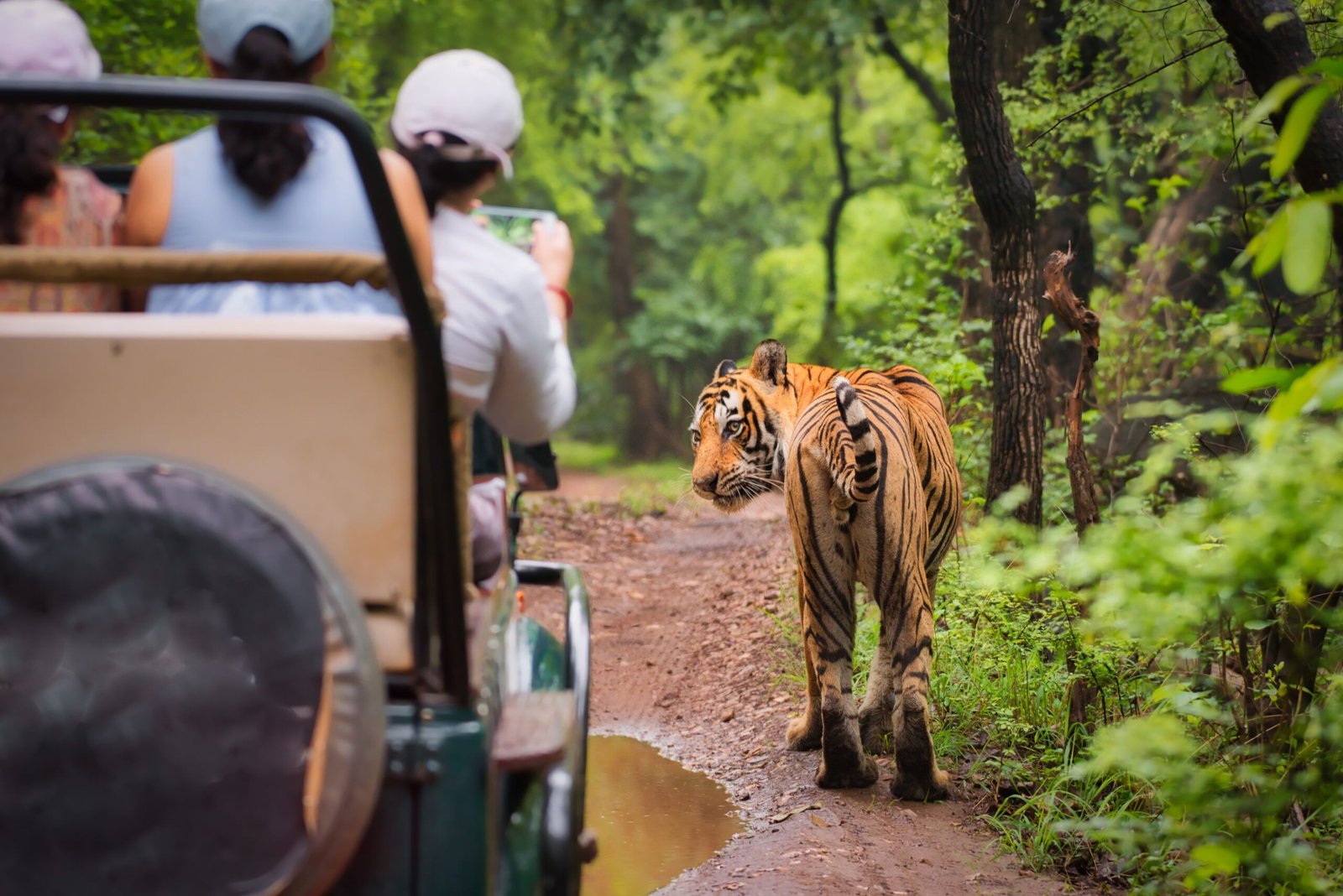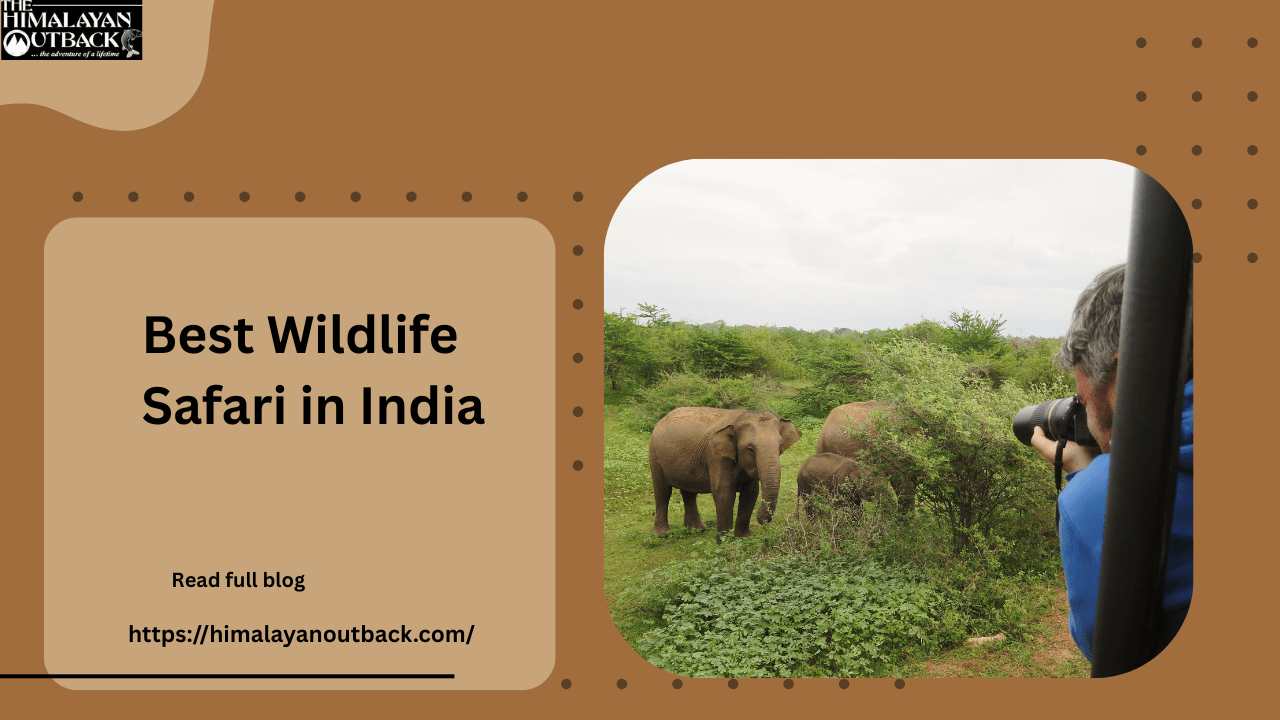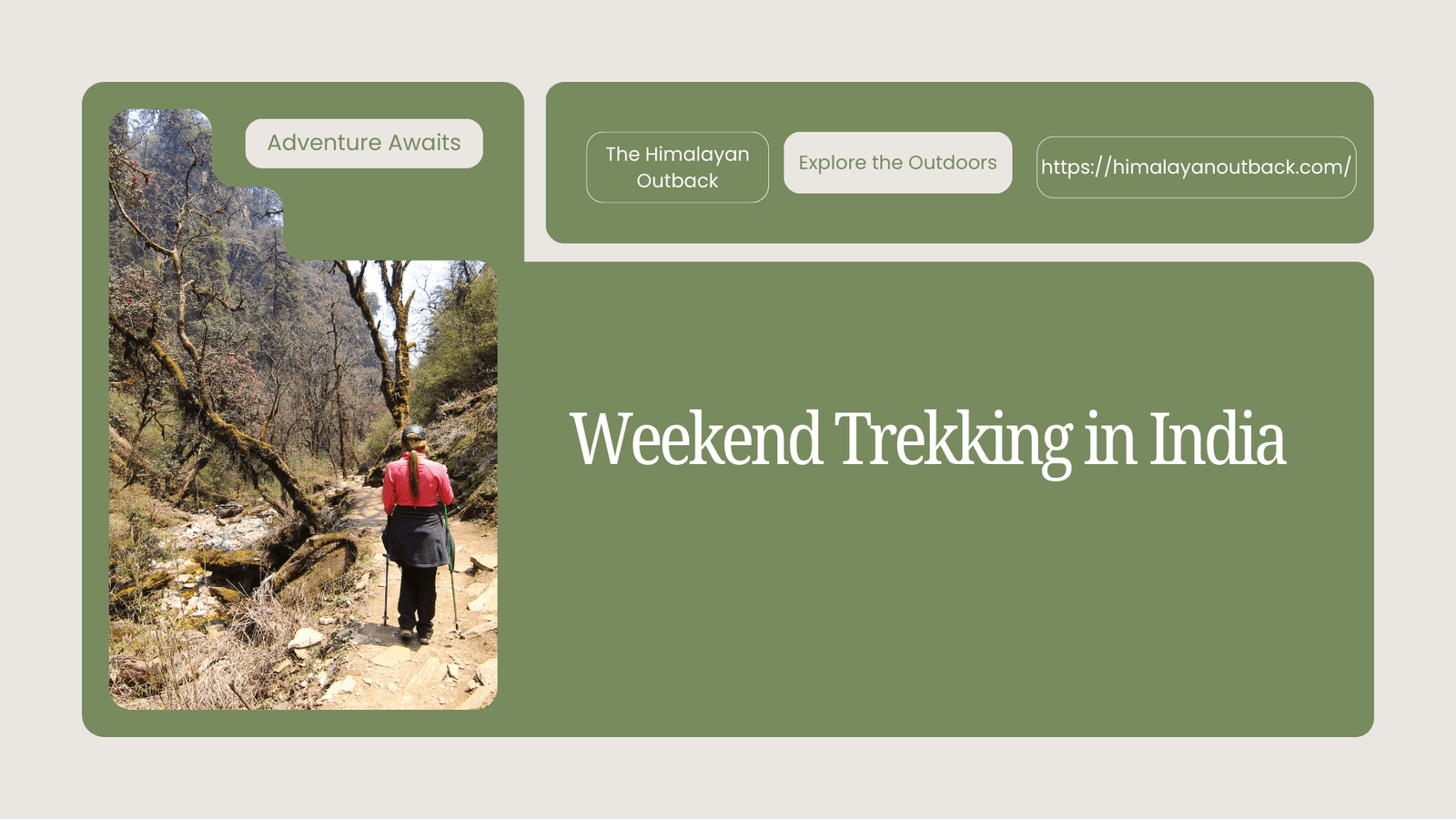The roar of a Royal Bengal tiger echoes through dense bamboo groves. An eagle’s cry pierces the tranquil afternoon air. A herd of spotted deer cautiously approaches a waterhole while a massive crocodile remains perfectly still, waiting for the perfect moment to strike.
Welcome to the wild heart of India, where Rudyard Kipling found inspiration for The Jungle Book and where nature’s most magnificent creatures roam free in their ancestral homes. A safari in India offers more than just wildlife viewing—it’s a journey into landscapes that have remained virtually unchanged for centuries, where every rustle in the undergrowth could reveal a legendary predator or a rare bird species found nowhere else on Earth.
From the tiger reserves of central India to the lion kingdom of Gujarat, from the crocodile-infested mangroves of the Sundarbans to the elephant corridors of the Western Ghats, India’s national parks and wildlife sanctuaries offer some of the world’s most thrilling and diverse safari experiences. Whether you’re tracking the elusive snow leopard in the high Himalayas or searching for the one-horned rhinoceros in Assam’s grasslands, every safari in India promises encounters that will leave you breathless and forever changed.

Jim Corbett National Park: Where Tiger Conservation Began
Established in 1936 as Hailey National Park, Jim Corbett holds the distinguished title of India’s first national park. Named after the legendary hunter-turned-conservationist Jim Corbett, this pioneering reserve in Uttarakhand set the standard for wildlife protection across the subcontinent.
The park’s crown jewel remains the Royal Bengal tiger, whose majestic presence draws wildlife enthusiasts from around the globe. During your safari in India’s most historic park, you’ll venture through diverse ecosystems that support over 160 bird species and 50 mammal species. Barking deer bound through sal forests, while spotted deer and sambar graze in grassland clearings. The park’s rivers harbor mugger crocodiles, adding an element of prehistoric wonder to your jungle adventure.
Corbett’s varied terrain—from dense forests to riverside grasslands—creates perfect tiger habitat. The park’s success in tiger conservation has made it a model for wildlife protection programs throughout Asia. Beyond tigers, visitors frequently spot leopards, sloth bears, and the occasional elephant herd migrating through the park’s corridors.
Best visiting season: November through June offers optimal wildlife viewing conditions, with cooler temperatures encouraging animals to venture into open areas.
Ranthambore: Rajasthan’s Royal Tiger Kingdom
Few destinations capture the essence of a safari in India quite like Ranthambore National Park. Set against the backdrop of a 1,000-year-old fort, this Rajasthan gem combines historical grandeur with exceptional wildlife viewing opportunities.
Ranthambore’s tigers have achieved celebrity status among wildlife photographers, known for their bold daylight appearances and tolerance of safari vehicles. The park’s relatively open terrain and numerous lakes create ideal conditions for tiger sightings, making it one of India’s most reliable destinations for seeing these magnificent cats.
The park’s ecosystem extends far beyond its famous tigers. Leopards prowl the rocky outcrops, while jackal packs patrol the grasslands. The park supports healthy populations of nilgai (blue bull antelope), chital, and sambar deer. Sloth bears emerge from caves during cooler months, and over 300 bird species call Ranthambore home.
The landscape itself tells a story of resilience—ancient ruins emerge from dense forests, while crystalline lakes reflect the sandstone cliffs of the Aravalli Hills. This dramatic setting provides photographers with countless opportunities to capture wildlife against backdrops of incredible beauty.
Optimal visiting period: October through June provides the best wildlife viewing, with peak season falling between December and April.
Gir National Park: The Last Kingdom of Asiatic Lions
Entering Gir National Park feels like stepping into an exclusive domain ruled by one of the world’s rarest big cats. This Gujarat sanctuary serves as the final stronghold of the Asiatic lion, a subspecies that once roamed from Greece to eastern India but now exists only within Gir’s protected boundaries.
The park’s 1,400 square kilometers of dry deciduous forest provide perfect habitat for approximately 500 Asiatic lions. These magnificent predators, slightly smaller than their African cousins, display unique behaviors adapted to their forest environment. Unlike African lions that prefer open savannas, Gir’s lions have mastered the art of hunting in dense woodland.
A safari in India’s lion kingdom reveals an ecosystem carefully balanced around its apex predator. Spotted deer form the lions’ primary prey, while wild boar populations thrive in the forest undergrowth. Striped hyenas scavenge in the lions’ wake, and leopards have adapted to a more arboreal lifestyle to avoid direct competition.
The park’s vegetation showcases the beauty of western India’s dry forests. Teak trees tower overhead, while khair and dhok trees create a dense canopy. During the brief monsoon season, the forest transforms into a green paradise, supporting over 300 bird species including the spectacular Indian pitta and the paradise flycatcher.
Prime visiting season: December through March offers cooler temperatures and optimal wildlife activity.
Kanha National Park: Inspiration for The Jungle Book
Spanning 940 square kilometers across Madhya Pradesh, Kanha National Park provided Rudyard Kipling with inspiration for The Jungle Book. This UNESCO-recognized park combines exceptional biodiversity with successful conservation programs that have brought several species back from the brink of extinction.
Kanha’s greatest conservation triumph involves the barasingha, or swamp deer. Once facing extinction with fewer than 66 individuals in the 1970s, the population has recovered to over 800 thanks to dedicated conservation efforts. These graceful deer, with their distinctive 12-point antlers, now thrive in Kanha’s carefully managed grasslands.
The park’s tiger population represents one of central India’s most stable breeding populations. Kanha’s tigers roam through sal forests, bamboo groves, and meadows that provide ideal hunting grounds. The park’s open terrain and numerous water sources create excellent conditions for tiger photography and behavioral observation.
Wild dogs, India’s most endangered large carnivore, find sanctuary in Kanha’s diverse landscape. These highly social predators hunt in coordinated packs, providing visitors with thrilling wildlife encounters. Leopards, sloth bears, and Indian bison complete the park’s impressive predator lineup.
Best visiting window: Mid-October through June provides optimal weather and wildlife viewing conditions.
Bandhavgarh: India’s Tiger Capital
With the highest density of tigers in India, Bandhavgarh National Park in Madhya Pradesh offers unparalleled opportunities for tiger encounters during your safari in India. This ancient landscape, steeped in 2,000 years of history, combines exceptional wildlife viewing with archaeological wonders.
The park’s compact core zone concentrates wildlife around numerous water sources, creating some of India’s most reliable tiger viewing opportunities. Bandhavgarh’s tigers, descended from a small founding population, display unique behaviors and territorial patterns that researchers have studied for decades.
Ancient caves and ruined temples scattered throughout the park add historical depth to every safari. The hilltop Bandhavgarh Fort, dating to the 2nd century BCE, overlooks the entire reserve and provides context for the region’s cultural significance.
Beyond tigers, the park supports diverse wildlife populations including Indian bison, wild boar, and four species of deer. The endangered white-rumped vulture and long-billed vulture find refuge here, part of conservation programs working to restore India’s vulture populations.
Ideal visiting season: October through June offers the best combination of weather and wildlife activity.
Pench National Park: Mowgli’s Real Home
The adventures of Mowgli spring to life in Pench National Park, where Rudyard Kipling set his beloved Jungle Book stories. Straddling the border between Madhya Pradesh and Maharashtra, this biodiverse reserve showcases central India’s rich natural heritage.
The Pench River bisects the park, creating distinct ecosystems on either side. Riverside forests support different wildlife communities than the drier upland areas, providing habitat diversity that supports over 285 bird species and 39 mammal species.
Pench’s tiger population has steadily increased over recent decades, making it an excellent destination for tiger tracking. The park’s varied terrain—from teak forests to bamboo groves—provides tigers with diverse hunting opportunities and creates dramatic backdrops for wildlife photography.
Four critically endangered vulture species find sanctuary in Pench: the white-rumped vulture, long-billed vulture, white scavenger vulture, and king vulture. These magnificent birds play crucial ecological roles, and their conservation represents one of India’s most important wildlife success stories.
Peak visiting season: February through April provides optimal viewing conditions with comfortable temperatures and active wildlife.
Sundarbans: The Tiger’s Aquatic Kingdom
The Sundarbans represents a unique chapter in any safari in India experience. This UNESCO World Heritage Site, formed by the confluence of the Ganges, Brahmaputra, and Meghna rivers, creates the world’s largest mangrove forest and India’s most unusual tiger habitat.
Sundarbans tigers have adapted remarkably to their aquatic environment. These swimming cats navigate tidal channels with ease, developing unique hunting strategies that set them apart from their forest-dwelling cousins. Local folklore and conservation efforts intertwine here, where tigers are revered as water spirits while being protected through community-based initiatives.
The mangrove ecosystem supports incredible biodiversity beyond its famous tigers. Ridley sea turtles nest on remote beaches, while saltwater crocodiles patrol the muddy channels. Spotted deer have adapted to the tidal rhythms, feeding on salt-tolerant vegetation that grows nowhere else in India.
Boat-based safaris provide the only access to this remote wilderness, offering a completely different perspective on Indian wildlife. The interplay of tides, wildlife movements, and weather creates ever-changing safari conditions that make each visit unique.
Optimal season: September through March provides the most stable weather conditions for boat-based wildlife viewing.
Planning Your Ultimate Safari Adventure
Each destination offers unique experiences that contribute to the complete safari in India story. Consider combining multiple parks to experience the full spectrum of Indian wildlife—from desert-adapted lions to mangrove tigers, from forest elephants to high-altitude snow leopards.
The diversity of landscapes, wildlife, and cultural contexts makes India one of the world’s premier safari destinations. Every park tells a different chapter in the story of conservation, from the pioneering efforts at Corbett to the community-based programs in the Sundarbans.
Your Wild Adventure Awaits
India’s national parks and wildlife reserves offer more than just animal sightings—they provide windows into ecosystems that have evolved over millions of years and cultural traditions that have coexisted with wildlife for millennia. Every safari in India becomes a journey through time, connecting you with the natural world that inspired generations of writers, naturalists, and conservationists.
From the moment you hear your first tiger’s roar echoing through dawn mist to watching a leopard disappear into dappled forest shadows, these experiences reshape your understanding of our planet’s wild heritage. The memories forged during your best wildlife safari in India will inspire a lifetime of conservation awareness and natural world appreciation.
Plan your journey to these incredible destinations, where every game drive reveals new wonders and every sunset brings fresh possibilities for tomorrow’s adventures. India’s wild kingdoms await your discovery.






